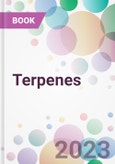This book set explores compounds of interest to researchers and clinicians. It presents a comprehensive analysis about the medicinal chemistry (drug design, structure-activity relationships, permeability data, cytotoxicity, appropriate statistical procedures, molecular modelling studies) of different compounds. Each chapter brings contributions from known scientists explaining experimental results which can be translated into clinical practice.
Volume 2 presents (1) a detailed overview of the polypharmacology of sesquiterpenes, (2) an interesting journey around the globe of cannabinoids revealing the development of new synthetic Δ9-THC derivatives, (3) the design of specific formulations to overcome the volatility of small sized terpenes-based essential oils, (4) an update on the latest generation of endoperoxides that display antimalarial activity and, finally, (5) a summary of MedChem strategies to fix common issues faced in formulating terpene derivatives (such as low potency and poor solubility).
The objective of this book is to fulfil gaps in current knowledge with updated information from recent years. It serves as a guide for academic and professional researchers and clinicians.
Table of Contents
Chapter 1 Sesquiterpenes: a Terpene Subclass With Multifaceted Bioactivities- Introduction
- Sesquiterpenes
- Caryophyllane Sesquiterpenes
- Chemistry and Distribution in Nature
- Pharmacological Properties
- Sesquiterpene Lactones
- Chemistry and Distribution in Nature
- Pharmacological Properties
- Eremophylane Sesquiterpenes
- Chemistry and Distribution in Nature
- Pharmacological Properties
- Safety and Toxicological Concerns of Sesquiterpenes
- Concluding Remarks
- Consent for Publication
- Conflict of Interest
- Acknowledgement
- References
- Niccolò Chiaramonte and Nathalie Saraiva Rosa Introduction
- History of Cannabis Sativa L.
- Biogenesis of Phytocannabinoids
- Total Synthesis of Δ9-Thc
- Cannabinoid Receptors
- Endocannabinoid System
- Synthetic Cannabinoids
- Inferring the Structure-Activity Relationship: Classical Cannabinoids Derived from Δ9-Thc and Δ8-Thc
- Tricycle Scaffold
- Geminal Dimethyl Function
- Methyl Group in 9
- C-1 Hydroxyl Group
- C-3 Alkyl Chain
- Conclusion
- List of Abbreviations
- Consent for Publication
- Conflict of Interest
- Acknowledgements
- References
- Patrizia Paolicelli, Stefania Petralito, Jordan Trilli, Laura Di Muzio, Stefania Garzoli and Maria Antonietta Casadei Introduction
- Terpene Hydrocarbons
- Oxygenated Compounds
- Nanoencapsulation of Essential Oils
- Liposomes
- Solid Lipid Nanoparticles and Nanostructured Lipid Carriers
- Nanoemulsions and Microemulsions
- Concluding Remarks
- Consent of Publication
- Conflict of Interest
- Acknowledgments
- References
- Grazia Luisi Introduction
- The Nature-Derived Mainstays of Antimalarial Therapy
- Sesquiterpene Lactone Endoperoxides: a Natural Source of 1,2,4- Trioxane-Containing Antimalarial Drugs
- The Class of Sesquiterpene Lactones
- Sesquiterpene Lactone Endoperoxides: the Artemisinin Family
- The Discovery of the Nobel Molecule
- The Bioactivity Profile of Artemisinin
- The Production of Artemisinin
- Uncovering Artemisinin Structure and Key Determinants for Activity
- The Mechanism of Plasmocidal Action
- Resistance to Artemisinin
- Artemisinin Derivatives and Analogs
- Artemisinin Combination Therapy
- Artemisinin Molecular Hybrids
- Artemisinin Dimers and Trimers
- Dioxanes and Dioxolanes
- Trioxanes and Trioxolanes
- Trioxanes
- Trioxolanes
- Tetraoxanes
- Conclusion
- Consent for Publication
- Conflict of Interest
- Acknowledgements
- References
- Subject Index








